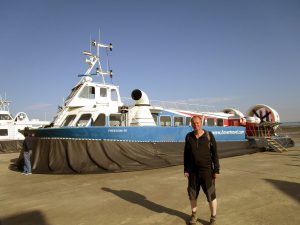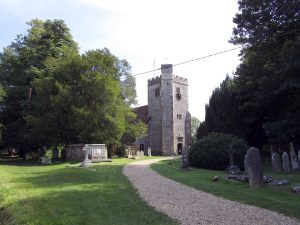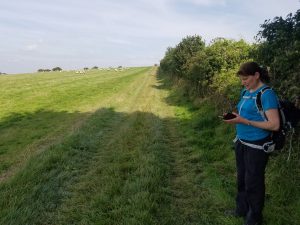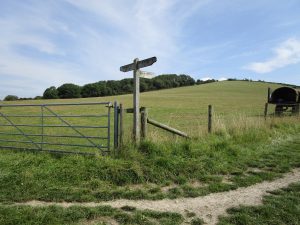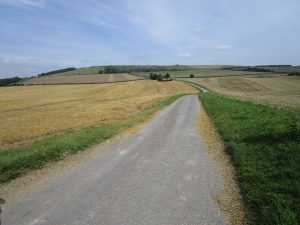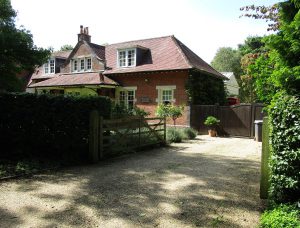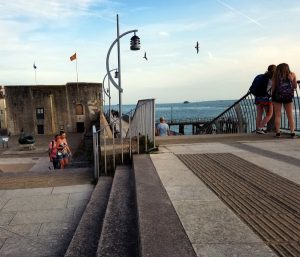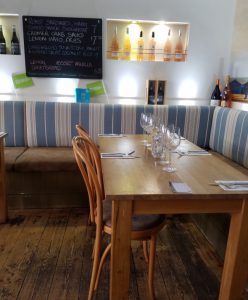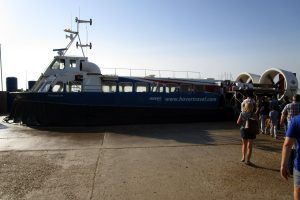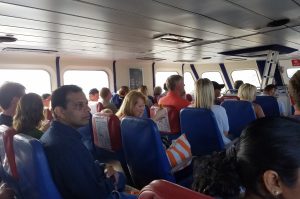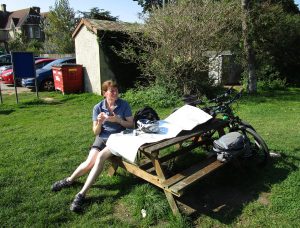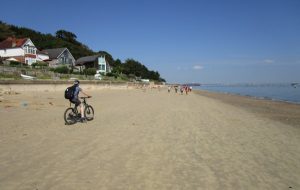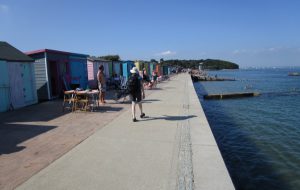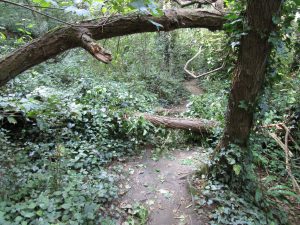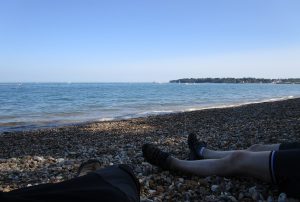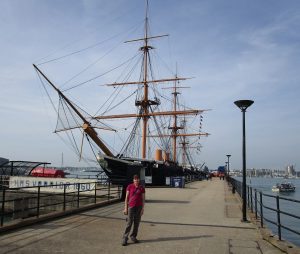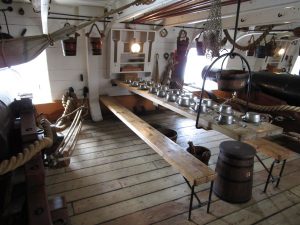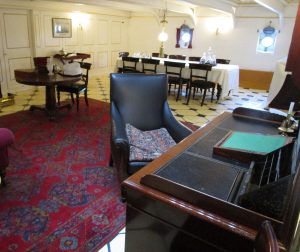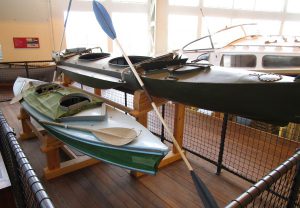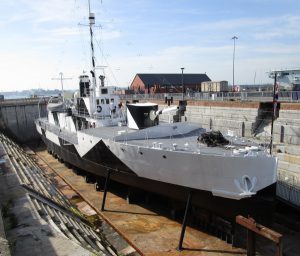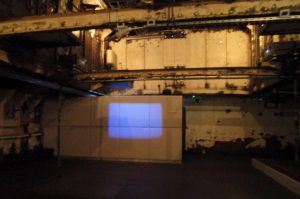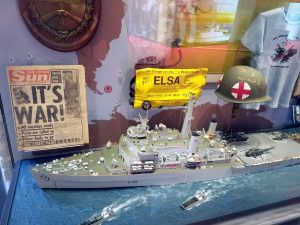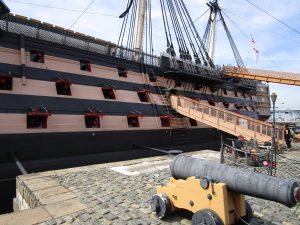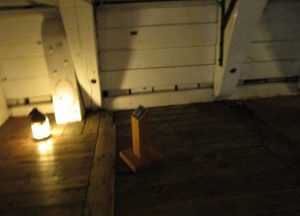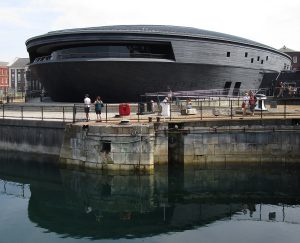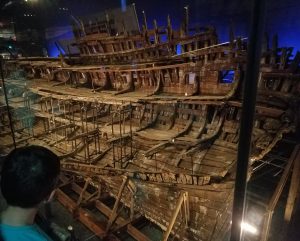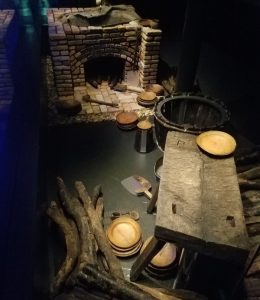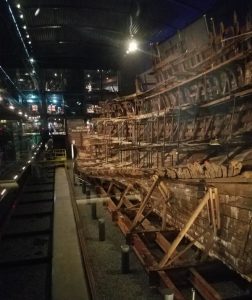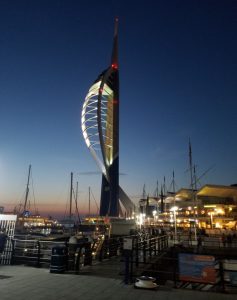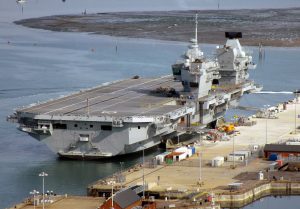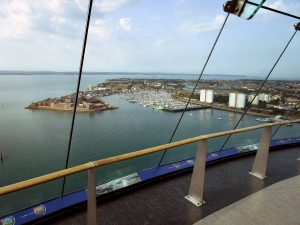I’d wanted to visit Portsmouth Historic dockyard and see many of the museums and ships there.
The Isle of Wight lies just across the water from Portsmouth and has Europe’s only regularly running Hovercraft service (and I’d never been on a Hovercraft).
Finally, HMS Elizabeth had docked in Portsmouth and there was a chance to see it up close.
Well, one of those would be enough reason to go, but with all that going on, I arranged a 4 day trip and off we went.
While visiting that part of the world, it seemed crazy not to do some walking in the South Downs (a National Park I’d not visited before).
We stayed at a nice pub called The Roebuck in a place called Droxford. We arrived in the evening, had a nice pie and mash and a few drinks before retiring to bed.
In the morning, we set of on an 8 mile circular walk, beginning at the church above, where a wedding was taking place.
The route we chose was from walking world, a website I can’t recommend more highly.
With their route’s, most of the works is done for you, with a simple map and a series of pictures and descriptions showing the route in an ABC format. All we had to do was walk.
If we were looking for high mountains, we’d be unlucky, but the endless rolling fields were spectacular.
We’d found England’s green and pleasant land.
At one point we join a section of the South Downs way.
And follow a long windy road back into town.
The walking world notes had mentioned a really nice pub that had recently opened and on such a beautiful day it seemed daft not to visit.
When we got there unfortunately, it had closed down.
What we did find, was the original train station, which is now a private residence.
It has significance from the first world war as Churchill and many of Britain’s allies, met here in secret to plan D Day.
Back at the car, the wedding had just finished and we cheered the happy couple on their new life together.
Driving to Portsmouth, our home for the next 3 nights, we walk along the water front and I’m amazed to find there’s a sort of seaside thing going on with bumper cars and slot machines.
Further along is the old port, where we can look out to sea. The Royal Navy is based here, and throughout its history ships have sailed from here on various missions.
Portsmouth has a historic dockyard, a modern military port and a thriving commercial port, so there’s plenty going on.
After a bit more exploring we head to our planned dinner destination.
The Abarbistro restaurant was superb.
It also incorporated a wine merchant so we had a wide selection to go with our meal.
In the morning, were up bright and early and head to the Hovercraft Port (its £22 per person for a return journey).
You select the specific time you want to go, but if you want to go or come back at an alternative time and there’s space available then they will let you switch.
Having never been on a Hovercraft before, I really enjoyed it (and the people around me seemed to as well).
As it was early in the day, the Sea had receded quite far and the Hovercraft glided from the ocean to the sand and cruised up to the hoverport in Ryde.
We had a day in the Isle of Wight and exploring by bicycle seemed like the thing to do.
We rented 2 bikes from Tackt Isle adventures (who were extremely professional and very friendly) based 6 miles from Ryde, in a lovely spot called the Duver.
They also taught sailing, rented out sea canoes and offered all sorts of other adventure importunities.
I was a bit disappointed as on this occasion we only had time to do mountain biking, but I’ll go back for a week next time 🙂
Setting off, we stop for some coffee near the beach, spread out our map and choose our cycle route.
We cycle around the coast for most of the day, occasionally heading inland and seeing various sights along the way.
As we’d chosen mountain bikes, we were able to do an occasional beach ride which was really exciting.
Late in the day, with our cycling complete we head back to Ryde.
Since its such nice weather we’ll walk back.
We occasionally leave the coast and head inland following trails through forests like this one.
And obviously having an occasional rest on the beach to relax.
Back in Ryde we have a dinner reservation at Olivo. Its then I realise how far up the hill it is.
Olivo was a superb restaurant, and just like everything else I saw in the Isle of Wight, I’ll be going back to visit it again.
We get the 10pm Hovercraft home. This time the sea is right up to the harbour and the hovercraft glides straight onto it.
Our 3rd day, and this time were visiting the Historic dockyard to see some of the museums and ships on display.
This ship, HMS Warrior was the most advanced warship of her kind when she was built in Victorian times, complete with an Iron clad hull and a a steam engine to compliment her sails.
Inside the gun deck, 18 men to a gun which would fire a cannonball weighing 5 stone.
They also slept and ate here in teams, but during combat could fire one cannonball every 55 seconds, 3 times faster than the French or the Dutch.
Our guide was a friendly type and even asked if there were any French or Dutch people there so he could “ribg” them !.
Interestingly, its guns were never fired in anger.
In contrast to smaller ships like HMS Victory which I’d see later, this thing was opulent.
This is the captains cabin, which has a desk, dining table and sleeping quarters.
The gun crew slept in hammocks above their guns.
We visited a warehouse where young people are taught how to make boats in the traditional style from wood.
While there, we had some excellent coffee in a place called the Midships Cookhouse.
As I left I saw these military canoes typical of the kind used in Cockleshell heroes.
The M33 was used in the first world war and an example of “modern” ships made of steal.
She had a galley, where bacon and things like that were cooked.
She was called the “lucky ship” and we found out why.
Inside was a video about the ill feted Gallipoli campaign.
The M33 was constructed in 7 weeks with a thin bow, so it could sail in close and bombard the coast.
During the whole time, the ship didn’t sustain a single hit (not even a bullet).
Amazing when you think that the Turkish army who were “dug in” (by military standards, the safe bet in an exchange like this) lost 83,000 men. A tragedy which I hope will never be repeated.
Inside the Royal Navy museum, there was far too many interesting things to write about here.
Instead I’ve just picked one section, which talked about the Falklands conflict (I remember being 13 and watching updates on it each evening when I got home from school. I’ll be going there on a cruise next year).
HMS Victory, probably the most famous ship in the historic dockyard.
If your expecting it to be painted gold or yellow, they’ve actually re-painted it in the colours that Admiral Nelson would recognise.
There’s an entire museum about Admiral Nelson and his life.
Suffice to say, when he sailed the fleet to Trafalgar, Britain’s national heritage was at stake.
When the flag message “England expects…” was sent out, he knew if he failed to beat the combined French and Spanish Navies, Britain would become a French colony.
He was shot by a French sniper and taken bellow decks. As he lay dying he was told that the battle was over and Britain had been victorious. This is the spot where he died..
It’s interesting to think how the quality of British food might have improved if he’d failed. I guess we’ll never know.
The Mary Rose museum is quite new and from the outside has the sort of UFO appearance.
Henry the 8th founded the Royal Navy. He watched the Mary Rose capsize and sink in Portsmouth harbour.
Many will remember (and there’s a video of it, for those that don’t) when it was re-floated floated in 1982. While watching it on tv, I was a bit disappointed as I was expecting a “proper” boat and it was just a pile of old wood.
What looked at the time to be the flat bottom of the deck, was actually 1 side of the boat. The other side had rotted away.
For years the museum was just some old wood with water being pored over it constantly.
The new one, has the remaining side mounted upright on one side and various artefacts from the boat mounted on the other.
In this way its possible to walk through the middle on 3 different levels and imagine what it would have been like to stand inside the belly of this ship.
Various research had been done of the years and they had even re-constructed the brick oven that would have fed all of those onboard the ship.
Inside the main room at ground level.
It really is a spectacular exhibit and if you’ve seen it before in its previous form (as Nikki had) I’d urge you to go back, its well worth it.
We wander back to the harbour for dinner (its a fab atmosphere there with lots of nice bars and restaurants).
As we head back to our hotel, I get a look at the Spinnaker, where were booked to visit the next day at 9:30am.
And from the top of the Spinnaker, an amazing view of HMS Elizabeth, Britain’s newest aircraft carrier.
Looking out across the Solent, a final picture to remember Portsmouth.
An incredible trip – like Arnold Schwarzenegger famously said “I’ll be back”.
